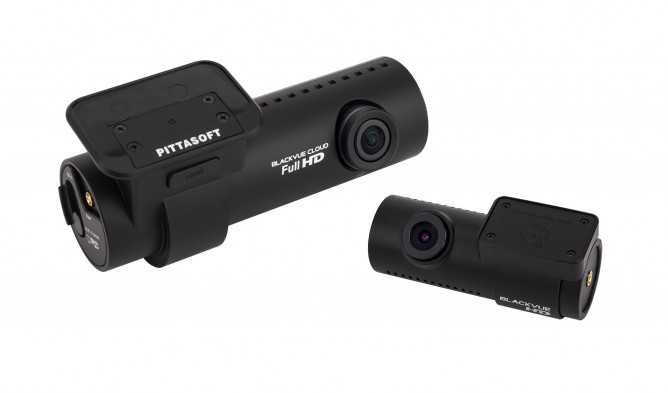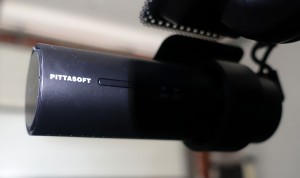
BlackVue is one of the best brands available today for dashcam. DR750S-2CH is a dual-channel dash camera with cloud connectivity and impressive image quality, thanks to its dual full HD camera capable of recording 60 fps (front) and 30 fps (rear). With 139° view angle, these cameras are capable to capture almost everything around a car. STARVIS imaging sensors in both cameras bring video clarity under low light.
To make this nice dashcam even better, it packs built-in GPS logger, Wi-Fi, Cloud connectivity, impact and motion detection. It does not have built-in screen though. Instead of requiring more space for screen, DR750S-2CH looks slim and sleek, taking up minimum space. Almost all settings and functionalities are operated via app in our phones, with Wi-Fi connectivity. The app itself is reasonably well-designed with 3 main options: to connect to dashcam via cloud, via Wi-Fi or access internal memory.
Just like most other dashcams, BlackVue DR750S-2CH stores the recordings into a micro-SD card. Even though technically we can put any micro-SD card into the storage slot, it is highly recommended to use MLC-type, which has significantly higher endurance. It makes sense, because dashcam continuously access the micro-SD card in all kinds of weather condition. When a car is parked outdoor on a 35C day, the temperature inside can be far higher. BlackVue spent a lot of efforts trying to warn their users to always use their brand of micro-SD card and I see no good reason not to comply. I use BlackVue-branded card and so far everything works fine.
 There are 4 LEDs on the front unit: recording LED, GPS LED, Wi-Fi LED, and security LED. There is only 1 security LED on the rear unit. The front unit has one button and one touch-sensitive surface. The button is used to turn on/off Wi-Fi, reset the Wi-Fi SSID and password or to format the memory card. The touch sensitive surface is located on the left side and it toggles audio recording on/off or triggers manual recording depending on the firmware settings. I personally do not like the idea of voice recording, so I always turn it off.
There are 4 LEDs on the front unit: recording LED, GPS LED, Wi-Fi LED, and security LED. There is only 1 security LED on the rear unit. The front unit has one button and one touch-sensitive surface. The button is used to turn on/off Wi-Fi, reset the Wi-Fi SSID and password or to format the memory card. The touch sensitive surface is located on the left side and it toggles audio recording on/off or triggers manual recording depending on the firmware settings. I personally do not like the idea of voice recording, so I always turn it off.
DR750S-2CH has built-in speaker and it provides useful interaction feedback. The built-in GPS helps to record video locations, and will help to make a stronger evidence for insurance claims. Just like other dash-cams, BlackVue will record video in a loop, overwriting older files when the memory is full. BlackVue DR750S-2CH can prevent Event files (triggered manually or by impacts) overwriting. Up to fifty videos can be protected this way. As a nice bonus, the combination of GPS and speaker would alert us when the vehicle speed is above certain threshold. I find this feature useful. In highest quality setting, 1 minute of front camera recording (1080p, 60fps) is around 90 MB. The rear camera recording (1080p, 30 fps) takes approximately 75 MB.
I had these cameras professionally installed, with the optional Power Magic Pro to protect the vehicle’s battery. Therefore I can’t comment much on the installation process. I can, however, note that Power Magic Pro does help me from any worry that my dashcam will drain my battery power. It turns off the dashcam automatically when I do not use the vehicle for more than a day.
From the app, we can set a lot of things related to the dashcam. Basic setting allows us to set date, time and time zone, choose video resolution and set enhanced night vision. It also allow us to display date & time in the video, choose our speed unit, lock even files and rear camera rotation. I didn’t know about this rear camera rotation setting and apparently my rear camera was installed from above. My rear recordings in the first few days are upside down, until I realised that I need to turn on this setting.
Next setting section is sensitivity. DR750S-2CH can detect impact to the vehicle based on 3-axis acceleration sensor. In the setting, we can set the sensitivity level of this automatic detection. System settings allow us to customise the LEDs, the function of touch sensitive surface, toggle voice guidance for various functionalities, schedule device reboot and add user text overlay. Wi-Fi setting allow us to rename the SSID and Wi-Fi password. Cloud settings let the device to remember 3 Wi-Fi connections for its Internet connection. When one of those connections are available, the dashcam will automatically connect itself to the cloud. This is also linked to push notifications that we will receive in our phone. Naturally the camera can only notify us with anything when it has Internet connection.
When browsing video recordings from the app, there are 4 built-in filters. We can choose to display all recordings, or we can toggle videos from N (normal), E (event), P (parking) or M (manual) mode. Since one file contains recording of 1 minute, the list of files can get overwhelming soon, so these filters would definitely help.
I got a bit of mixed experience with the cloud connection. I put the home Wi-Fi as its first priority connection, hoping that it would always get connected when the vehicle is parked at home. It really should, because there is a Wi-Fi repeater in the garage so signal strength should never be a problem. In reality, I kept on getting tons of notifications in my app telling that the dashcam is getting connected, then disconnected, then connected again. On good days, there could be only around 3-5 pairs of connected and disconnected notices. On bad days I could get up to 30 pairs (60+ notifications). I still could not understand what triggers more disconnections.
When it works, cloud connection is helpful for me to quickly change device settings. Transferring video over cloud is just so unbearable I decided not to do it, ever. So I always use dashcam’s built-in Wi-Fi when I need to copy some recordings to my local storage.
The impact detection, although sounds cool when reading the specifications, is too sensitive in my opinion. Even at lowest sensitivity setting, it detects every rail-crossing and little road bumps as events. Well, it still records the video, but it ends up giving us too many false positives, making the E (event) filter in my app less meaningful. At lowest sensitivity setting, the impact detection on parking mode always trigger a notification when I close the vehicle’s door. At high sensitivity setting, the impact detection on parking mode would flood me with a lot of notification with the vehicle parked nicely in a closed garage. I did special investigation on what actually triggered those notifications. Turned out, if detects any visual movement on the camera as “impact”. So flying bird that’s visible from a small window behind the garage gave me those notifications.
Last but not least, the video recording quality. BlackVue DR750S-2CH captures amazing quality video. Watching the front camera video feels like watching HD movie download from iTunes. The videos from rear camera look great too. On its own, the recordings look fantastic for a dashcam result, but when you watch it right after watching the video from the front camera, you will notice some differences. At the bottom there’s some information on the date and time, vehicle speed, status of audio recording, BlackVue model number and the selected video quality.
DR750S-2CH is an excellent product and I love it. It has its quirks and certainly not perfect, but it does its main job very well. Hopefully future firmware upgrades will make this dashcam even better.

Leave A Comment